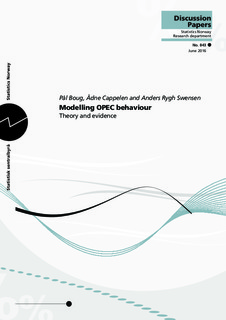| dc.contributor.author | Boug, Pål | |
| dc.contributor.author | Cappelen, Ådne | |
| dc.contributor.author | Swensen, Anders Rygh | |
| dc.date.accessioned | 2018-10-31T12:25:00Z | |
| dc.date.available | 2018-10-31T12:25:00Z | |
| dc.date.issued | 2016-07-01 | |
| dc.identifier.issn | 1892-753X | |
| dc.identifier.uri | http://hdl.handle.net/11250/2570384 | |
| dc.description.abstract | We analyse the behaviour of OPEC as a group for the period 1992 to 2015 by formulating a model that encompasses several of the alternatives discussed in the literature.
There is no consensus in the literature on how OPEC behaviour affects crude oil prices. Some studies treat the oil market as a standard competitive market where OPEC plays no important role, whereas others argue that OPEC is a dominant producer with a competitive fringe or a cartel that adjusts its production to influence crude oil prices in a way that benefits the member states. We analyse the behaviour of OPEC as a group for the period 1992 to 2015 by formulating a model that encompasses several of the alternatives discussed in the literature. Applying a system-based cointegration analysis, we find support for the imperfect competition hypothesis regarding the output decision of OPEC. We also find, using full information maximum likelihood and recursive methods, that a dynamic equilibrium correction model with imperfect competition is reasonably stable in-sample and has somewhat better fit than an alternative dynamic model with weaker theoretical underpinnings. However, a forecasting exercise reveals that the dynamic equilibrium correction model breaks down following the OPEC meeting in November 2014. At the end of 2015 the model underpredicts the production of OPEC by almost 2.5 million barrels per day. We therefore conclude that the OPEC behaviour has changed significantly, probably to limit the role of competitors like American producers of shale oil. | nb_NO |
| dc.language.iso | eng | nb_NO |
| dc.publisher | Statistisk sentralbyrå | nb_NO |
| dc.relation.ispartofseries | Discussion Papers;No. 843 | |
| dc.subject | Oljepriser | nb_NO |
| dc.title | Modelling OPEC behaviour. Theory and evidence | nb_NO |
| dc.type | Working paper | nb_NO |
| dc.subject.nsi | VDP::Samfunnsvitenskap: 200::Økonomi: 210::Samfunnsøkonomi: 212 | nb_NO |
| dc.source.pagenumber | 21 s. | nb_NO |
